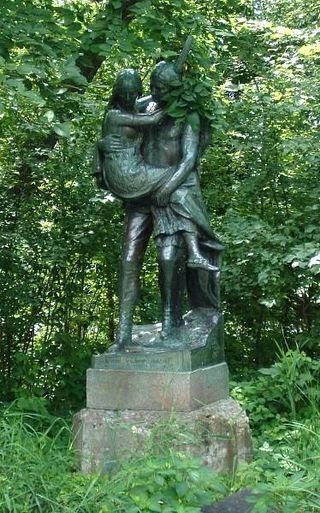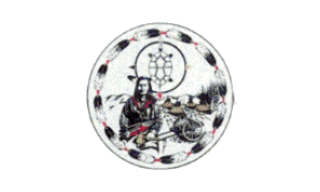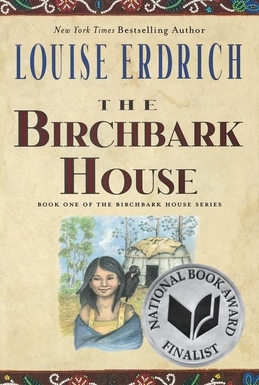
The thunderbird is a legendary creature in particular North American indigenous peoples' history and culture. It is considered a supernatural being of power and strength.

A protagonist is the main character of a story. The protagonist makes key decisions that affect the plot, primarily influencing the story and propelling it forward, and is often the character who faces the most significant obstacles. If a story contains a subplot, or is a narrative made up of several stories, then each subplot may have its own protagonist.

Anishinaabe traditional beliefs cover the traditional belief system of the Anishinaabeg peoples, consisting of the Algonquin/Nipissing, Ojibwa/Chippewa/Saulteaux/Mississaugas, Odawa, Potawatomi and Oji-Cree, located primarily in the Great Lakes region of North America.

The Ojibwe, Ojibwa, Chippewa, or Saulteaux are an Anishinaabe people in what is currently southern Canada, the northern Midwestern United States, and Northern Plains. They are Indigenous peoples of the Subarctic and Northeastern Woodlands.

The Song of Hiawatha is an 1855 epic poem in trochaic tetrameter by Henry Wadsworth Longfellow which features Native American characters. The epic relates the fictional adventures of an Ojibwe warrior named Hiawatha and the tragedy of his love for Minnehaha, a Dakota woman. Events in the story are set in the Pictured Rocks area of Michigan on the south shore of Lake Superior. Longfellow's poem is based on oral traditions surrounding the figure of Manabozho, but it also contains his own innovations.
Wendigo is a mythological creature or evil spirit originating from the folklore of Plains and Great Lakes Natives as well as some First Nations. It is based in and around the East Coast forests of Canada, the Great Plains region of the United States, and the Great Lakes region of the United States and Canada, grouped in modern ethnology as speakers of Algonquian-family languages. The wendigo is often said to be a malevolent spirit, sometimes depicted as a creature with human-like characteristics, which possesses human beings. The wendigo is said to invoke feelings of insatiable greed/hunger, the desire to cannibalize other humans, and the propensity to commit murder in those that fall under its influence.

Ojibwe, also known as Ojibwa, Ojibway, Otchipwe, Ojibwemowin, or Anishinaabemowin, is an indigenous language of North America of the Algonquian language family. The language is characterized by a series of dialects that have local names and frequently local writing systems. There is no single dialect that is considered the most prestigious or most prominent, and no standard writing system that covers all dialects.
Sisu is a Finnish concept described as stoic determination, tenacity of purpose, grit, bravery, resilience, and hardiness. It is held by Finns to express their national character. It is generally considered not to have a literal equivalent in English. In contemporary psychology, sisu is shown to have both beneficial and harmful sides which can be measured using a designated scale.

The Anishinaabe are a group of culturally related Indigenous peoples present in the Great Lakes region of Canada and the United States. They include the Ojibwe, Odawa, Potawatomi, Mississaugas, Nipissing and Algonquin peoples. The Anishinaabe speak Anishinaabemowin, or Anishinaabe languages that belong to the Algonquian language family.
Mississippi River Band of Chippewa Indians or simply the Mississippi Chippewa, are a historical Ojibwa Band inhabiting the headwaters of the Mississippi River and its tributaries in present-day Minnesota.

The Midewiwin or the Grand Medicine Society is a secretive religion of some of the Indigenous peoples of the Maritimes, New England and Great Lakes regions in North America. Its practitioners are called Midew, and the practices of Midewiwin are referred to as Mide. Occasionally, male Midew are called Midewinini, which is sometimes translated into English as "medicine man".
Psychological resilience is the ability to cope mentally and emotionally with a crisis, or to return to pre-crisis status quickly.

Ottawa or Odawa is a dialect of the Ojibwe language spoken by the Odawa people in southern Ontario in Canada, and northern Michigan in the United States. Descendants of migrant Ottawa speakers live in Kansas and Oklahoma. The first recorded meeting of Ottawa speakers and Europeans occurred in 1615 when a party of Ottawas encountered explorer Samuel de Champlain on the north shore of Georgian Bay. Ottawa is written in an alphabetic system using Latin letters, and is known to its speakers as Nishnaabemwin 'speaking the native language' or Daawaamwin 'speaking Ottawa'.

Madeline Island is an island in Lake Superior. Now part of Ashland County, Wisconsin, it has long been a spiritual center of the Lake Superior Chippewa. Although the largest of the Apostle Islands, it is not included in the Apostle Islands National Lakeshore. It is the only island in the Apostle Island chain open to commercial development and private ownership.

Chief Buffalo was a major Ojibwa leader, born at La Pointe in Lake Superior's Apostle Islands, in what is now northern Wisconsin, USA.
The Anishinaabe, like most Algonquian-speaking groups in North America, base their system of kinship on clans or totems. The Ojibwe word for clan was borrowed into English as totem. The clans, based mainly on animals, were instrumental in traditional occupations, intertribal relations, and marriages. Today, the clan remains an important part of Anishinaabe identity. Each clan are not allowed to harm their representation animal in any way or form. It is an bad omen if you do so.
The culture of Minnesota is a subculture of the United States with influences from Scandinavian Americans, Finnish Americans, Irish Americans, German Americans, Native Americans, Czechoslovak Americans, among numerous other immigrant groups. They work in the context of the cold agricultural and mining state.

Turtle Mountain Indian Reservation is a reservation located in northern North Dakota, United States. It is the land base for the Turtle Mountain Band of Chippewa Indians. The population of the Turtle Mountain Indian Reservation consists of Plains Ojibwe and Métis peoples; the reservation was established in 1882.
In psychology, grit is a positive, non-cognitive trait based on a person's perseverance of effort combined with their passion for a particular long-term goal or end state. This perseverance of effort helps people overcome obstacles or challenges to accomplishment and drives people to achieve.

The Birchbark House is a 1999 indigenous juvenile realistic fiction novel by Louise Erdrich, and is the first book in a five book series known as The Birchbark series. The story follows the life of Omakayas and her Ojibwe community beginning in 1847 near present-day Lake Superior. The Birchbark House has received positive reviews and was a 1999 National Book Award Finalist for young people's fiction.












